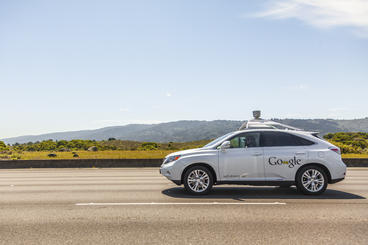Connected and Automated Vehicles: Opportunity for Equity, Accessibility, and Safety

In recent work, TPEC researchers focused on communities in the East Metro of the Twin Cities, particularly the east side, downtown, and Frogtown areas of Saint Paul. The research team used a combination of interviews and roundtable discussions to gather a range of stakeholders’ perspectives on transportation challenges and CAV technologies.
The researchers concluded that CAVs alone cannot solve systemic inequities, but planners and policymakers can make decisions that avoid the same disparities of past planning decisions. A notable takeaway, they say, is that policy needs to take a stronger role in guiding private development to address equity issues as CAV technology develops.
The East Metro research builds on earlier TPEC efforts that gathered input from local officials, stakeholders, and community members in Grand Rapids, St. Cloud, Mankato, and Fergus Falls.
Current CAV work by the TPEC team includes partnering on demonstration projects and pilot deployments with White Bear Lake, Grand Rapids, and the University of Minnesota CAV Ecosystem.
Task force report, community outreach
TPEC researchers formed a self-driving vehicle (SDV) task force in the spring of 2017 to identify how various SDV deployment strategies could improve mobility and access for transportation-dependent Minnesotans: seniors, people with disabilities, and others who are not able to drive themselves.
The task force was made up of representatives from the Minnesota Department of Transportation, Metro Mobility, local governments, nonprofits, and organizations from the Twin Cities and Greater Minnesota. At the close of its work, the task force constructed a Matrix of Users to cross-compare geography, barriers to participation, and the potential forms of self-driving transportation that may be implemented in Minnesota. The matrix separated Minnesota’s population into four geography ranges: central city, suburban, small city, and rural locales. Read the Self-Driving Vehicles Task Force Report and Matrix of Users (2017).
As follow-up to the task force, TPEC initiated stakeholder meetings across the state. In Grand Rapids, Minnesota, the researchers held two meetings with representatives from foundations and public agencies, people with disabilities, and others. The team also engaged the Region 9 Board of Directors and other local groups in Mankato and met with Saint Cloud’s area planning organization.
Building on this work, a newer project sought to uncover the needs of transportation-disadvantaged communities in the Twin Cities East Metro area. Researchers conducted interviews with human service providers and transportation practitioners to gain an understanding of transportation challenges and opportunities, as well as potential CAV implications. They also hosted a virtual roundtable with transportation program staff from a variety of organizations to discuss the potential implications of CAVs in urban contexts, with an emphasis on equity. Together, the interviews and roundtable produced a number of key findings. Learn more in a TPEC research brief: Connected and Automated Vehicles: Opportunity for Equity, Accessibility, and Safety (2020).
National conference, journal special issue
At a conference cosponsored by TPEC in 2014, state and national leaders explored the various legal, ethical, technical, and policy dimensions of self-driving vehicles. The conference—Automated Vehicles: The Legal and Policy Road Ahead—featured presentations and discussions of industry and design perspectives, civil liability and insurance, criminal liability, regional and city planning perspectives, and ethics, equity, and access.
Articles based on the conference were published in the spring 2015 issue of the Minnesota Journal of Law, Science & Technology, a multidisciplinary journal edited by University of Minnesota faculty and law students.
Roundtables: technologies and transportation equity
A series of roundtable discussions hosted by TPEC in 2016 investigated the policy impacts of new transportation technologies. The roundtables specifically explored the impacts of the digital infrastructure and self-driving vehicles.
Discussion topics included opportunities and obstacles for improved mobility and access for people who cannot drive, possible impacts of self-driving vehicles on urban form, and broader impacts of the digital infrastructure on the physical infrastructure. Participants included U of M faculty and research staff, key members of state and local governments, and interested citizens.
Completed research
- The Impacts of Vehicle Automation on Transport-Disadvantaged People. Transportation Research Interdisciplinary Perspectives, 2021.
- Preparing Transit in the Advent of Automated Vehicles: A Focus-Group Study in the Twin Cities. Findings, 2020.
- Identifying the Opportunities and Obstacles of Connected and Automated Vehicles in Rural Minnesota: Community Engagement in Greater Minnesota (2019)
- Self-Driving Vehicles Task Force Report and Matrix of Users (PDF), 2017
- Self-Driving Vehicles: Current Status of Autonomous Vehicle Development and Minnesota Policy Implications, Minnesota Journal of Law, Science & Technology, 2015
- Self-driving cars: As revolutionary in the 21st century for public health as vaccines were in the 20th, University of Minnesota School of Public Health Ignite! Symposium video, Feb. 2016
- Options for Automated Speed Enforcement Pilot Projects in Minnesota Work and School Zones, May 2014, Report no. CTS 14-06
- Understanding the Economic Effects of Flexibility through Three Employer Case Studies, February 2013, Report no. MnDOT 2013-07
- Investigating Deployment Potential for Automated Speed Enforcement in Minnesota (2012)
- Minnesota Field Test of CrashHelp (2012)
- Identifying Issues Related to Deployment of Automated Speed Enforcement - FY12 TechPlan (2011)
- ITS Data Needs: How Much Do We Really Need to Know? - FY11 TechPlan (2011)
- ITS and Locational Privacy: Suggestions for Peaceful Coexistance - FY10 TechPlan (2009)
- Viability of Personal Rapid Transit in the Minneapolis-St. Paul International Airport (2010)
- Viability and Benefits of Automated Rapid Transit for Minnesota (2010)
- Minnesota UPA Telework Component (2008)
- Privacy Issues of ITS (2005)
- Developing ITS to Serve Diverse Populations (2004)